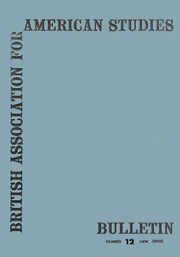No CrossRef data available.
Article contents
The Implementation of the Civil Rights Act of 1964: Title VI and the Use of Federal Funds
Published online by Cambridge University Press: 17 February 2011
Extract
The passage of the Civil Rights Act of 1964 by the United States Congress was a landmark not merely because of the manner in which Congressional opposition to the bill was overcome, but also in the potential effect of the legislation upon a variety of Federal programmes, in particular the use of Federal funds to implement such programmes. The Civil Rights Act of 1964, itself preceded by a period of intense and unprecedented civil rights agitation, in turn provoked further bouts of agitation, culminating in the attempts to register Negro voters in Selma, Alabama, and the march from Selma to Montgomery, Albama. Because of this, that section of the Act (Title 1) concerned with more effective enforcement of the right to vote in Federal elections has gained considerable prominence, especially following the presentation to Congress in March, 1965, of recommended legislation designed to enforce the 15th Amendment to the Constitution. However, one of the most significant and far-reaching sections of the Act is that relating to, and affecting, the use of Federal funds by Federal agencies. Under Title VI of the Act every Federal agency providing financial assistance through grants, loans or contracts, is required to eliminate discrimination in these programmes on the grounds of race, colour or national origin. This power could be a powerful lever for the President to force state governmental agencies to eliminate such discrimination in their programmes or risk the loss of vital Federal funds to supplement such programmes. It provides an important potential economic sanction on many Southern states and its effects may be far-reaching. The importance of Title VI can be seen by reference to particular areas where it has already been implemented.
- Type
- Research Article
- Information
- Copyright
- Copyright © British Association for American Studies 1965




